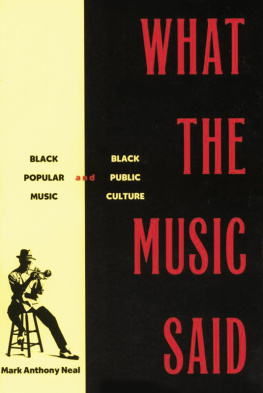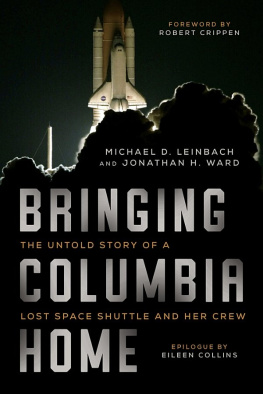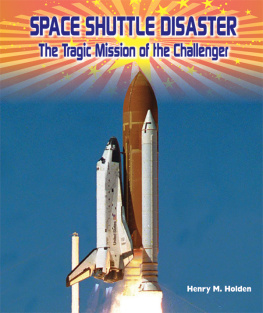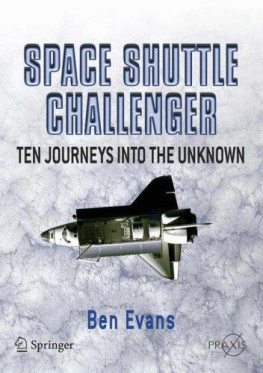DISCOVERY
Champion of the Space Shuttle Fleet
Valerie Neal
Curator, Smithsonian National Air and Space Museum


Smithsonian
National Air and Space Museum
Washington, D.C.
In association with

ACKNOWLEDGMENTS
Without holding him responsible for the contents of this book, I freely admit that a biography of Discovery would not have come to fruition so well without the unfailingly generous attention of Dennis R. Jenkins, my informal collaborator and quality control officer. He is an engineer and manager whose long career has been focused on the Space Shuttle, and he knows as much as, and probably more than, anyone about these remarkable vehicles. An author in his own right with many aviation and aerospace books to his credit, Dennis is now completing a three-volume technical history of the Space Shuttle, a work even more definitive than his classic earlier volumes on the history of the Space Transportation System.
Over the years, Dennis and I became acquainted through our work on Enterprise and Discovery, he as engineer-manager and I as curator. In the midst of concentrating on his magnum opus, Dennis graciously read my manuscript, gently guided me toward clarity on any matters needing correction, and helped me sort out credible data when sources differed. One might think that the number of orbits or maximum altitude of a shuttle mission would be a cold, hard absolute, but no; reports sometimes vary, so the numbers become slippery, and he helped me reconcile such discrepancies. He also gave me access to selected documents and images in his reference collection. Fortunately, we are both sticklers for details and patient in the effort to get things right, and this book is much more factually reliable due to his collegial involvement. Thank you, Dennis.
Thanks to NASA for putting so much information online, making it possible to write a book like this at all hours of the day and night, on weekends and holidays, without the constraints of office hours. Press kits, news releases, mission status reports, mission summaries, post-flight videos, crew interviews, photographs, and much more are so readily accessible that one need hardly step away from the computer to do research. At times, I had up to ten NASA websites open as I was writing, fact-checking, and tracking down pesky details.
Mary J. (Jody) Russell, who works in the media resource center at NASA Johnson Space Center, deserves credit for her knowledge of the image collection and her impeccable customer service. She is a one-woman rapid response team in filling requests for high-resolution images that are not available online. Like Space Shuttle workers I have known, she always gives her best effort without delay. Margaret A. (Maggie) Persinger in the media archives at NASA Kennedy Space Center also assisted quite ably in locating certain desirable photos.
The staff of the National Air and Space Museum Archives, both the archivists and the photographers, are always a helpful resource, and I tapped them for aid in illustrating the last chapter, Discoverys Final Mission. From the millions of images in the collection, they can find the perfect one or take a new one. For this project, archivists Amanda Buel, Allan Janus, Melissa Keiser, and Jessamyn Lloyd, as well as photographer Dane Penland, merit special notice. Almost everyone else on the museums staff became involved in planning and executing Discoverys transfer and display; without their teamwork and enthusiasm, none of that would have happened.
Patricia J. Graboske, publications officer at the museum, offered this project to me and nurtured our relationship with the publisher. She, Lawana Bryant in the Smithsonian Office of Contracts, and Jo Ann Morgan in the Space History Department deftly handled all the administrative matters. Space history intern Lynn Atkin helpfully compiled mission and crew data for the mission summaries. The Zenith Press editorial and design teams assigned to this project turned their many talents to making Discoverys story into a beautiful book. As editorial director for Zenith Press, Erik Gilg was excited about the book from the outset and promoted it enthusiastically. It has been a pleasure to work with all of them to publish Discoverys story.
Finally, I offer heartfelt appreciation to some people who are farther removed from this project but nevertheless merit acknowledgment. First are the two men who hired me in 1980 and put me to work on shuttle and Spacelab missions for a decade before I came to the National Air and Space Museum. Edwin C. Pruett of Essex Corporation and Charles R. (Rick) Chappell, a scientist at NASA Marshall Space Flight Center, saw potential in a newly minted PhD historian and encouraged me to write on spaceflight, space science, and space technology. It became my lifes work, an adventure I never anticipated. Then, working on NASA and museum projects brought me into contact with many scientists, engineers, managers, and astronauts over the years who were generous in sharing their knowledge. They are too numerous to name, but I trust they know that our conversations made me smarter.
If I do justice to Discovery here, it is because these knowledgeable friends and colleagues influenced my growth as a writer and curator in the Space Shuttle era.
DISCOVERY AND THE SPACE SHUTTLE ERA
On August 30, 1984, Discovery launched on its first mission with a six-person crew to deploy three communications satellites and conduct science experiments. NASA
Discovery became the champion of the Space Shuttle fleet not simply because it flew more missionsthirty-nine in allthan Columbia, Challenger, Atlantis, and Endeavour. It also served longertwenty-seven yearsspending altogether 365 days in space. Its flight history began in 1984 as the fleet was starting its busiest two years and ended in 2011 as the shuttle program wound down. Most distinctively, Discovery flew every type of mission and served every purpose for which the Space Shuttle was designed. Discovery had no rival in the variety of its missions and the range of firsts it attained.
Discoverys story is the full Space Shuttle story in microcosm. Its thirty-nine-episode narrative traces high and low points in the four-decade quest by the United States to make human spaceflight in Earth orbit routine, practical, economical, and safe. Discovery alone lifts the story from tragedy back to triumph as the return-to-flight vehicle after both shuttle accidents. Its flight history makes Discovery a robust icon for the entire shuttle era.
The Space Shuttle came into being in the 1970s to continue American spaceflight after the space race and landings on the moon. With no national appetite for an expensive grand venturea space station or a mission to Marsand with social problems at home, the United States settled on a new Space Transportation System (STS): a fleet of shuttles designed for missions in Earth orbit. Flying often on various types of missions, shuttles presumably would reduce the cost of human spaceflight and expand its purpose. If they proved successful, shuttles might later pave the way to a space station or deep-space expeditions.










